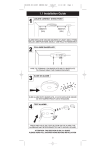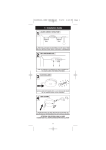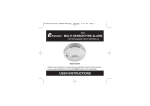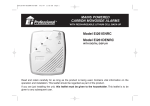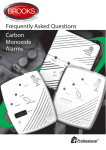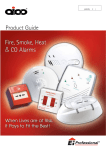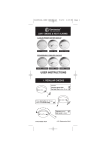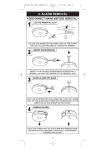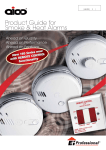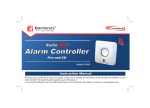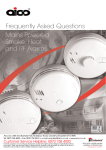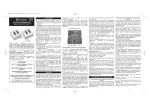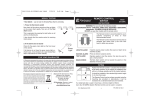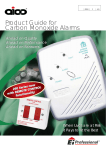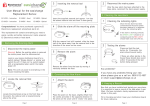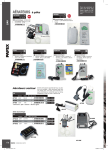Download Ei Electronics Ei2110 User's Manual
Transcript
B16350-R0-Ei2100 SERIES-U&C.qxd 18/9/08 3:46 PM Page 1 230V~ MULTI-SENSOR FIRE ALARM with Rechargeable Lithium Cell Back-up Model: Ei2110 Contains vital information on unit operation and installation. Read and retain carefully. If you are just installing this unit this leaflet MUST be given to the householder. INSTALLER INSTRUCTIONS B16350-R0-Ei2100 SERIES-U&C.qxd 18/9/08 3:46 PM Page 2 CONTENTS 3 1. QUICK GUIDE 1.1 INSTALLATION GUIDE 4 1.2 ALARM REMOVAL 5 2. MULTI-SENSOR FIRE ALARM FEATURES 6 3. HOW MANY ALARMS TO INSTALL 7 3.1 CATEGORIES OF SYSTEM 9 3.2 SELECTING ALARM TYPE 13 3.3 GRADE D, E & F SYSTEMS 14 15 4. POSITIONING ALARMS 4.1 LOCATIONS TO AVOID 16 17 5. INSTALLATION 5.1 MOUNTING & WIRING ALARMS 19 5.2 INTERCONNECTING ALARMS 23 25 6. ACCESSORIES 2 B16350-R0-Ei2100 SERIES-U&C.qxd 18/9/08 3:46 PM Page 3 INSTALL IN THE CENTRE OF CEILING AT LEAST 300mm FROM LIGHT FITTINGS & WALLS INTERCONNECT ALL ALARMS ENSURE MAINS POWER IS CORRECTLY CONNECTED TO L & N TERMINALS ON ALL INTERCONNECTED ALARMS - OTHERWISE UNITS WILL BE DAMAGED DO NOT FIT ACTUAL ALARMS UNTIL ALL BUILDING WORK IS COMPLETED TO AVOID CONTAMINATION. AFTER CHECKING OPERATION, COVER ALARMS WITH DUST COVER UNTIL REQUIRED FOR USE DISCONNECT THE ALARMS BEFORE APPLYING HIGH VOLTAGE TO WIRING (FOR INSULATION TESTS) DO NOT ATTEMPT TO OPEN THE ALARM AS IT IS PERMANENTLY SEALED FOR SAFETY 3 B16350-R0-Ei2100 SERIES-U&C.qxd 18/9/08 3:46 PM Page 4 1.1 Installation Guide DECIDE ON CORRECT POSITION GREEN MAINS LIGHT PRESS AND HOLD THE TEST BUTTON ON THE ALARM. CHECK THE ALARM AND ANY INTERCONNECTED UNITS SOUND. AS THE TAMPER-PROOF CATCH ENGAGES. SWITCH ON MAINS 4 B16350-R0-Ei2100 SERIES-U&C.qxd 18/9/08 3:46 PM Page 5 1.2 Alarm Removal LOCATE REMOVAL SLOT INSERT SCREWDRIVER LOCATE THE ARROW ON THE FRONT FACE OF THE ALARM. THE SLOT IS LOCATED DIRECTLY ABOVE THE ARROW. INSERT A FLAT-BLADED SCREWDRIVER HORIZONTALLY ABOUT 10mm INTO THE CENTRE OF THE REMOVAL SLOT REMOVE ALARM SLIDE ALARM OFF BASE WITH THE SCREWDRIVER STILL INSERTED, PUSH THE LOWER HALF OF THE ALARM AWAY FROM THE SCREWDRIVER, IN THE DIRECTION OF THE ARROW ON THE COVER HOLD THE LOWER HALF OF THE ALARM AND REMOVE FROM THE BASE PLATE BY LOWERING THE ALARM TOWARDS THE FLOOR. 5 B16350-R0-Ei2100 SERIES-U&C.qxd 18/9/08 3:46 PM Page 6 2. MULTI-SENSOR FIRE ALARM FEATURES The state of the art EI2110 Multi-Sensor Fire Alarm, with its Heat enhanced Optical Smoke Sensor, has a significantly improved performance as described below. 1. Faster Response to a wider range of fires. The combination of the ultra fast temperature sensing thermistor and the high performance optical sensor within the unit, enhances the fire sensing performance such that the unit detects all the 7 different Test Fires (TF) specified in the standard BS ISO 7240-15: 2004. These Test Fires are designed to produce different levels of smoke/heat and as such are a good test of the units performance to the different fires that could possibly occur in the home. 2. Reduced Nuisance Alarms. The unit can tolerate up to 50% higher levels of cooking fumes and steam when compared with normal optical sensor alarms. 3. Increased Longevity and Ruggedness. The unit can tolerate up to 100% more dust and contamination build-up when compared with normal optical sensor alarms. This is due to the unique automatic DUST* compensation built into the unit which monitors the contamination in the smoke sensing chamber and adjusts the alarm trigger point accordingly. *DUST – Dust Ups Sensor Threshold. Additionally, the optical sensor chamber features a fine mesh insect screen that is bonded to the plastic of the chamber. This significantly improves immunity to insect contamination. 6 B16350-R0-Ei2100 SERIES-U&C.qxd 18/9/08 3:46 PM Page 7 4. Replace Alarm Indicator. If the optical sensor chamber becomes very heavily contaminated, the amber fault light will flash once every 40 seconds to inform the user. Action can then be taken to replace the unit, long before the contamination causes nuisance alarms. 5. Alarm Memory. After a the unit has gone into alarm, the red alarm light will flash twice (1 second apart) every 40 seconds to indicate that the unit has alarmed in the previous 24 hours. Additionally, pressing the Test/Hush button on this unit will cause it to emit short, rapid beeps instead of the normal alarm sound. Both these features allow easy identification, for example, of the source of nuisance alarms during the night. 6. Single Person Interconnect Test Pressing and holding the Test button on the unit causes the alarm to sound. On releasing the test button, the alarm will immediately cease but all interconnected alarms will continue to sound for 3 seconds. This allows easy audible check of alarm interconnection. 3. HOW MANY ALARMS TO INSTALL - CATEGORIES & GRADES The ideal system would consist of Multi-Sensor Fire Alarms installed throughout the dwelling apart from the kitchen which should have a Heat Alarm installed (Note: alarms should not be installed in toilets/bathrooms). 7 B16350-R0-Ei2100 SERIES-U&C.qxd 18/9/08 3:46 PM Page 8 The Multi-Sensor Alarm can be installed for superior performance anywhere the regulations specify an Optical Smoke Alarm or an Ionisation Smoke Alarm. (The Ei2110 Multi-Sensor Fire Alarm can also be used and interconnected with an Ei166RC Optical Smoke Alarm or an Ei161RC Ionisation Smoke Alarm if necessary). The advice here follows the guidance in British Standard BS 5839-Part 6:2004 in general (for further information see the BS standard itself). The main reason for fitting alarms in dwellings is to ensure that when there is a fire, sufficient early warning is given so that everybody can escape safely. This means that the fire alarms should ideally be located in all escape routes and in all rooms that contain potential sources of fire. Another important consideration is that the alarm should be heard throughout the house – particularly in the bedrooms. It is also important that nuisance/false alarms are minimised to ensure the units are not disabled or ignored. BS 5839-Part 6:2004 gives guidance on: - how many alarms to install - what type of alarm to use - where to position alarms The above points will depend on the type of dwelling to be protected and the level of fire risk. Fire Risk Assessment The ‘Grade’ and ‘Category’ of system that should be installed depends on the fire risk. 8 B16350-R0-Ei2100 SERIES-U&C.qxd 18/9/08 3:46 PM Page 9 It is therefore recommended that a Fire Risk Assessment is undertaken. The Risk Assessment would be based on a combination of probabilities: - fire occurring - injury or death to occupant - system operating correctly with a fire - early detection and warning to occupants in the event of a fire. The greater the risks, the more comprehensive and reliable systems are needed. 3.1 Categories of System There are three Categories of LD systems for Life protection in Dwellings that can be installed, depending on the fire risk and regulations. Please see following pages for detailed information. 9 B16350-R0-Ei2100 SERIES-U&C.qxd LD3 18/9/08 3:46 PM Page 10 MINIMUM PROTECTION for existing dwellings Shower Bedroom Minimum Protection LD3: Alarms in all hallways, stairways and circulation areas that form part of the escape routes from the dwelling. Bedroom Multi-Sensor Fire Alarms located: on each storey every 7.5 m of hallways and escape routes within 3m of all bedroom doors (apart from toilets & bathrooms ) Bathroom Living Room Garage Kitchen Multi Storey Dwelling LD3 Bedroom Bedroom Bathroom Bedroom Kitchen / Dining Room Living Room Single Storey Dwelling LD3 Multi-Sensor Fire Alarm 10 do not fit alarm B16350-R0-Ei2100 SERIES-U&C.qxd 18/9/08 3:46 PM Page 11 LD2 ADDITIONAL PROTECTION for new or materially altered dwellings or existing dwellings with poor structural fire precautions Shower Bedroom Additional Protection LD2: As LD3, but in addition alarms in all rooms or areas that present a high fire risk to occupants. Bedroom Multi-Sensor Fire Alarms located: on each storey every 7.5 m of hallways and escape routes within 3m of all bedroom doors (apart from toilets & bathrooms ) Bathroom Living Room Heat Alarms located in: each Kitchen (Heat Alarms must be within 5.3m of potential fire sources) Garage Kitchen Multi Storey Dwelling LD2 Bedroom Bathroom Kitchen / Dining Room Multi-Sensor Fire Alarms or Heat Alarms located in: each Living room (i.e. most frequently used daytime room) Bedroom Bedroom Living Room Single Storey Dwelling LD2 Multi-Sensor Fire Alarm Heat Alarm 11 do not fit alarm B16350-R0-Ei2100 SERIES-U&C.qxd LD1 18/9/08 3:46 PM Page 12 OPTIMUM PROTECTION for dwellings where occupants may be at high risk (e.g. elderly) Shower Bedroom Optimum Protection LD1: As LD2, but in addition alarms should be located in all rooms and other areas of the dwelling. (apart from toilets or bathrooms) Multi-Sensor Fire Alarms located: on each storey every 7.5 m of hallways and escape routes within 3m of all bedroom doors in all other rooms & areas other than listed below (apart from toilets & bathrooms ) Heat Alarms located in: each kitchen garages (Heat Alarms must be within 5.3m of potential fire sources) Bedroom Bathroom Living Room Kitchen Garage Multi Storey Dwelling LD1 Bedroom Bathroom Kitchen / Dining Room Multi-Sensor Fire Alarms or Heat Alarms located in: each Living room (i.e. most frequently used daytime room) Bedroom Bedroom Living Room Single Storey Dwelling LD1 Multi-Sensor Fire Alarm Heat Alarm 12 do not fit alarm B16350-R0-Ei2100 SERIES-U&C.qxd 18/9/08 3:46 PM Page 13 3.2 Selecting Alarm Type Multi-Sensor Fire Alarm & Heat Alarm Selection Locations & Performance Alarm Type Multi-Sensor Fire Alarm Heat Alarm Locations Hall, Corridors, Escape Routes Kitchens 2 1 Living Rooms Bedrooms Shower / Bathroom Fire Response Slow Smouldering Fires (polyurethane foam, ignited bedding etc.) Fast Flaming Fires (flaming wood/plastic, oil, solvents, chip pans etc.) Temperature >580C 3 4 Nuisance Alarm Immunityy Cooking Fumes Steam, Condensation & Dust Build-up - Not Suitable - Better - Good 13 - Best 2 B16350-R0-Ei2100 SERIES-U&C.qxd 18/9/08 3:46 PM Page 14 1 Some Fire authorities (concerned with the slow response of Heat Alarms) advise that Smoke Alarms (or Multi-Sensor Alarms) should be fitted. This is acceptable according to BS 5839-6 provided there are clearly not going to be problems with nuisance alarms. Fit Heat Alarms only if nuisance alarms are very likely and it is acceptable that a warning will only be given by the Heat Alarm when there is a very significant flaming fire in the room. If the door(s) and windows are not closed to contain the fire and heat, it is extremely unlikely that the Heat Alarm would respond before a Multi-Sensor Alarm sited outside in the corridor. 2 In enclosed kitchens with doors closed. 3 Fast flaming fires generate considerable amounts of heat. The Multi-Sensor Fire Alarm has a heat enhanced optical smoke sensor to improve the response of the sensor to these types of fires. 4 Do not install in kitchens. Improved Audibility The effectiveness of Category LD2 and LD3 systems can be significantly enhanced if an additional alarm (interconnected) is installed in the master bedroom. This will help ensure that a responsible person will quickly be alerted to a fire and can arrange for an orderly evacuation of children and other vulnerable occupants. 3.3 Grade D, E & F Systems The mains powered, with battery back-up, Multi-Sensor Fire Alarm covered by these instructions will meet the requirements for a Grade D Systems (and exceed Grades E & F). A Grade D system is needed for: - new or materially altered dwellings up to three-storeys, with no floor over 200m2 in area - existing dwellings with poor structural fire precautions, up to three storeys, with no floor over 200m2 in area - Houses in Multiple Occupation (HMOs) of one or two-storeys, with no floor over 200m2 in area 14 B16350-R0-Ei2100 SERIES-U&C.qxd 18/9/08 3:46 PM Page 15 - Individual dwellings units of two or more rooms in HMOs Check that a Grade D system is adequate for the dwelling into which the system is being installed. 4. POSITIONING ALARMS The locations must comply with applicable building regulations. Hot smoke rises and spreads out, so a central ceiling position is the preferred location. The air is “dead” and does not move in corners, therefore alarms must be mounted away from corners. Place the unit: - At least 300mm away from walls. See Figure 1. - At least 300mm from any light fitting or decorative object which might obstruct smoke / heat entering the alarm. 300mm (min) 300mm 900mm Figure 1 Figure 2 15 B16350-R0-Ei2100 SERIES-U&C.qxd 18/9/08 3:46 PM Page 16 Note: Ceiling mounting is recommended - do not wall mount alarms. Sloping Ceiling In areas with sloping or peaked ceilings install the alarm 900mm from the highest point measured horizontally (see Figure 2). This is because “dead air” at the apex may prevent smoke from reaching the unit. 4.1 Locations To Avoid DON’T place Multi-Sensor Fire Alarms in any of the following areas: • Bathrooms, kitchens, shower rooms, garages or other rooms where the alarm may be triggered by steam, condensation, normal smoke or fumes. Keep at least 6 metres away from sources of normal smoke/fumes. DON’T place Heat Alarms in any of the following areas: • Bathrooms, shower rooms or other rooms where the unit may be triggered by steam or condensation. DON’T place Multi-Sensor Fire Alarms in any of the following areas: • Places where the normal temperature can exceed 40°C or be below 4°C (e.g. attics, furnace rooms, directly above ovens or kettles etc.) as the heat/steam could cause nuisance alarms. • Near a decorative object, door, light fitting, window moulding etc., that may prevent smoke or heat from entering the unit. • Surfaces that are normally warmer or colder than the rest of the room (e.g. attic hatches). Temperature differences might stop smoke or heat from reaching the unit. 16 B16350-R0-Ei2100 SERIES-U&C.qxd 18/9/08 3:46 PM Page 17 • Next to or directly above heaters or air conditioning vents, windows, wall vents etc. that can change the direction of airflow and cause rapid temperature fluctuations. • In very high or awkward areas (e.g. over stairwells) where it may be difficult to reach the unit (for testing, hushing etc.). • Locate away from very dusty or dirty areas as dust build-up in the optical sensor chamber can impair performance. It can also block the insect screen mesh and prevent smoke from entering the chamber. • Locate the unit at least 1m from dimmer controlled lights and wiring as some dimmers can cause interference. • Locate the unit at least 1.5m and route wiring at least 1m away from fluorescent light fittings as electrical “noise” and/or flickering may affect the unit. Do not wire into the same circuit as fluorescent lights or dimmers. • Do not locate in insect infested areas. Small insects getting into the optical sensor chamber can cause intermittent alarms. Insects and contamination on the heat sensor can increase its response time. 5. INSTALLATION The Alarm is designed to be permanently mounted, using it’s own built-in terminal block to connect it to the mains. The mounting plate can be screwed directly to the ceiling. Alternatively it can be screwed to a standard junction box. It requires a current of 60mA. The Alarm must not be exposed to dripping or splashing. There are important markings on the underside of the alarm. IMPORTANT PRECAUTION: Do not install alarms in new or renovated buildings until all work is completed (including floor coverings) and the building has been 17 B16350-R0-Ei2100 SERIES-U&C.qxd 18/9/08 3:46 PM Page 18 fully cleaned. The wiring can be installed when appropriate. (Excessive dust and debris from building work can contaminate the optical sensor chamber or heat sensor and cause problems. It will also invalidate the guarantee). If it must be installed, first cover it completely, particularly around the edges, with a dust cover (eg. with the elasticated cover supplied or a plastic bag), until all cleaning is finished. The alarm must not be connected when the house wiring insulation is being checked with high voltages. i.e. Do not use a high voltage insulation tester on the alarm. WARNING: Mains operated alarms should be installed and interconnected by a qualified electrician in accordance with the Regulations for Electrical Installations published by the Institution of Electrical Engineers (BS7671). Failure to install this alarm correctly may expose the user to shock or fire hazards. WARNING: The alarm must be continuously powered 24 hours a day so it is important that it is not on a circuit that can be turned off by a switch. Note: BS 5839-6: 2004 gives the following recommendations regarding the mains supply to be used in a Grade D system. The power supply for the alarms should be derived from the public electricity supply to the dwelling. The mains supply to the alarms should take the form of either: (a) an independent circuit at the dwelling’s main distribution board, in which case no other electrical equipment should be connected to this circuit (other than a dedicated monitoring device installed to indicate failure of the mains supply to the alarms); or (b) a separately electrically protected, regularly used local lighting circuit. Alarms should be connected on a single final circuit, unless the means of interconnection is by radio signals (e.g. RadioLINK). (See BS 5839-6: 2004 for further information) 18 B16350-R0-Ei2100 SERIES-U&C.qxd 18/9/08 3:46 PM Page 19 5.1 Mounting & Wiring Alarms 1. Select a location complying with the advice in previous sections (see pages 8-18). 2. Disconnect the AC mains supply from the circuit that is going to be used. 3. Lift off the wiring cover as shown in Figure 3. FOAM CEILING GASKET INSERT SCREWDRIVER TO LIFT AND REMOVE WIRING COVER Figure 3 19 B16350-R0-Ei2100 SERIES-U&C.qxd 18/9/08 3:46 PM Page 20 The wiring must be connected to the terminal block on the mounting plate as follows: L: Live - connect to the house wires coloured brown or marked L. N: Neutral - connect to the house wires coloured blue or marked N. IC: Interconnect - see page 23 & Figure 6 for information on interconnection. Note: Wiring must be installed in compliance with local regulations. Warning: Mixing the Live and Neutral connections when interconnecting alarms will damage all the alarms - ensure that the same colours are used throughout the premises for Live, Neutral and Interconnect wires. We strongly recommend that you check for the following before connecting the alarm: • check for Live and Neutral using a two probe tester. • check for Live using a neon tester. • check that the Interconnect wire is NOT connected to Live, Neutral or Earth. Do not use an Earth wire for the Interconnect line. N.B. The alarm does not need to be earthed. However the terminal marked is provided for the convenience of the installer so that any copper Earth wire or cable coloured green & yellow, can be safely terminated. To interconnect alarms connect all the IC terminals together as shown in Figure 4 (see “Interconnecting Alarms” section on page 23). 20 B16350-R0-Ei2100 SERIES-U&C.qxd 18/9/08 3:46 PM Page 21 REMOVEABLE TRUNKING DOOR FOR Figure 4 4. If the mains wires are recessed, bring the wires through the rear hole in the mounting plate as shown in Figure 4. If the mains wires are being brought along the surface: (a) position the mounting plate so the cable trunking is as shown in Figure 4. (b) the mounting plate has a removable section, take it out to interface directly with 25mm trunking as shown in Figure 5. If interfacing to 16mm trunking carefully cut around the marked section, leaving the top intact and replace the section. (If you are not using surface wiring, the removable section must be left in place for electrical safety reasons). 21 B16350-R0-Ei2100 SERIES-U&C.qxd 18/9/08 3:46 PM Page 22 Figure 5 There are two other positions which are also suitable for the surface wiring to enter (and exit) the alarm, one next to the removable section and another directly opposite. 5. Carefully align the mounting plate and screw into place. Connect the wires to the terminal block. With recessed wiring, ensure the rear gasket seals around the edge of the hole in the ceiling or wall. This is to prevent air draughts affecting the smoke/heat entering the alarm. If the hole is too large or the alarm does not seal it, it should be sealed with silicone rubber or equivalent. 6. Replace the wiring cover. 7. Carefully line up the unit on the base and slide on. 8. Press and hold the test/hush button for 10 seconds. The horn will sound. Check that any interconnected alarms also sound within this period. With the Multi-Sensor Alarm, the test button sounds the local horn and on release this horn stops immediately, and all the interconnected alarms can then be heard in the distance as they will continue to sound for a further 3 seconds. 22 B16350-R0-Ei2100 SERIES-U&C.qxd 18/9/08 3:46 PM Page 23 9. Connect the mains power to the alarm circuit. Check the green light on the front of the alarm is on. 10. Attach the ‘Smoke Alarm’ identification label provided to the distribution board to identify the alarm circuit. 11. Attach the ‘Mains Smoke / Heat Alarms’ label provided on or near the distribution board and write in date installed and the number of alarms on the circuit. Ensure the alarm operates correctly - see “TESTING & MAINTAINING YOUR ALARM” section on page 8 of the USER INSTRUCTIONS. 5.2 Interconnecting Alarms Note: A maximum of twelve Ei2110 Multi-Sensor Fire Alarms and/or Ei164RC Heat Alarms may be interconnected along with an Ei128R/Ei128RBU relay (see “ACCESSORIES” section on page 25). (Note the Multi-Sensor Fire Alarm Ei2110 can also be interconnected to Ei141/144/146/161RC/166RC Smoke/Heat Alarms if required). It can also be interconnected to Ei261ENRC/261DENRC Carbon Monoxide Alarms provided an Ei1529RC Remote Control Switch is incorporated in the system see page 25. Make electrical connections as shown in Figure 6. If you wish to connect more than twelve alarms contact your local distributor (see page 28 for details). Systems using more than 3 or 4 alarms must be very carefully planned to ensure nuisance alarms are not excessive. e.g. from cooking fumes or steam. The following is suggested: • A Remote Control Switch (model Ei1529RC) should be incorporated into the system 23 B16350-R0-Ei2100 SERIES-U&C.qxd 18/9/08 3:46 PM Page 24 and be readily accessible to all occupants so that the source of an alarm can be quickly identified. • All alarms must be cleaned and maintained regularly. • A qualified person must be on call to quickly remove any nuisance units (i.e. units with red light flashing rapidly) which are causing all the other alarms to sound. WARNING: Do not connect these alarms to any other type of Ei Alarm (apart from those listed above) or to any other model produced by another manufacturer. Doing so may damage the alarms and could result in a shock or fire hazard. Wiring must be installed in compliance with local regulations. In the UK it is recommended that the following coloured cores are used (for example with triple flat 6243YH cable). 230V supply Brown Neutral Grey - sleeved blue at terminations Interconnect Black In the Republic of Ireland consult the local regulations as they are different from the UK regulations. The interconnect wire (minimum 0.75mm2 cable) must be treated as if it was Live. It should be insulated and sheathed. A maximum of 250 metres of wire can be used (maximum resistance between detectors 50 Ohms). Alarms should be interconnected only within the confines of a single family living unit. If they are connected between different units there may be excessive nuisance alarms. 24 B16350-R0-Ei2100 SERIES-U&C.qxd 18/9/08 3:46 PM Page 25 Everybody may not be aware that they are being tested or that it is a nuisance alarm caused by cooking etc. Figure 6 Ensure the alarms operate correctly - see “TESTING & MAINTAINING YOUR ALARM” section on page 8 of the USER INSTRUCTIONS. 6. ACCESSORIES Relay Module Ei128R: The Ei128R module has a relay rated at 250V AC / 5 Amps. This is useful for triggering a remote device or remote signalling etc. Also available is the Ei128RBU Relay Module which has battery back-up. Remote Control Switch Ei1529RC: The Remote Control Switch is recommended for systems with three or more alarms. It allows the user to perform the following functions from a remote location: 25 B16350-R0-Ei2100 SERIES-U&C.qxd 18/9/08 3:46 PM Page 26 LOCATE - If alarms sound press Locate to allow source of alarm to be identified audibly. HUSH - Press Hush to silence nuisance alarms. TEST - Operate weekly to Test the alarms. MAINS CHECK - Test will not work with mains absent. RadioLINK Base Ei168RC: RadioLINK Bases are used to eliminate interconnect wiring and instead interconnect alarms using radio signals. This allows quick and easy installation as well as easy extension at a later date. The Ei2110 Multi-Sensor Fire Alarm (and Ei160RC Series Alarms) simply slide on to the Ei168RC RadioLINK Base. Each alarm in the system would need to be mounted on a RadioLINK Base. An Ei411H RadioLINK Remote Control Switch is also available that offers additional control functions similar to the Ei1529RC covered on page 25. 26 B16350-R0-Ei2100 SERIES-U&C.qxd 18/9/08 27 3:46 PM Page 27 B16350-R0-Ei2100 SERIES-U&C.qxd 18/9/08 3:46 PM Page 28 Aico Ltd. Mile End Business Park, Maesbury Rd, Oswestry, Shropshire SY10 8NN, U.K. Tel: 0870 758 4000 www.aico.co.uk Ei Electronics. Shannon, Co Clare, Ireland. Tel: 061 471277 www.eielectronics.com © Ei Electronics 2008 P/N B16350 Rev0 28




























